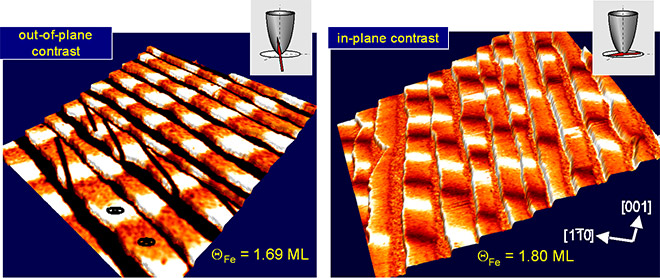Inhomogeneous spin spiral in stripes of double-layer Fe on stepped W(110)

Left: Fe double layer stripes as imaged by a magnetic tip with sensitivity to the perpendicular magnetization, revealing the magnetic domain structure with spins up and down.
Right: Same system, as imaged with a tip with in-plane sensitivity. Contrast is now found at the domain walls, all running in [1-10] direction. However, the in-plane (azimuthal) direction of the tip magnetization remained unknown. Thus, there are two possibilities to explain the domain wall contrasts: Bloch walls or Néel walls.
Each stripe forms a spin spiral consisting of sequences of domains and domain walls. The rotational sense is the same in all spirals, either left or right rotating. The spiral could be a helix (i.e. Bloch walls) or a cycloid (Néel walls). Only the 3D vector magnet system allowed answering these questions eventually. By application of small in-plane fields the azimuthal orientation of the tip magnetization could be controlled.
Contrasts are observed only when the applied in-plane magnetic field forces the tip magnetization into the [001] direction while contrasts vanish for the tip magnetization being oriented along [1-10], thus establishing the Néel character of the domain walls. In other words, the spin spiral is of the cycloidal type. Additional measurements in out-of-plane fields identified the sense of spin rotation, which is right handed.
This effect is caused by the so-called Dzyaloshinskii-Moriya interaction (DMI). In systems with broken inversion symmetry, as, e.g., the surface of a crystal, DMI allows a gain in energy from introducing an angle between neighboring spins. Ultimately, DMI results from relativistic spin-orbit interactions.
